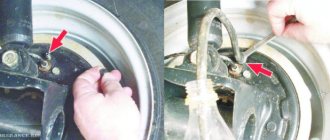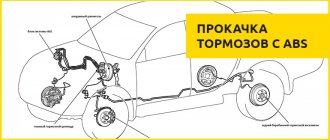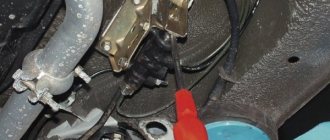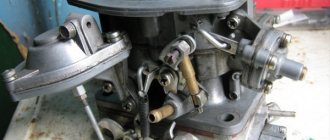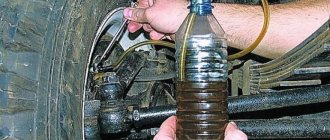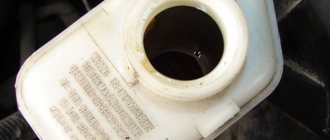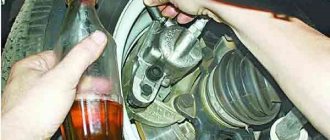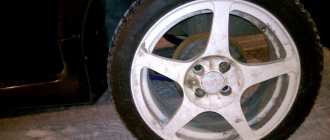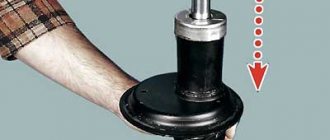A model of simplicity and reliability today, and a luxury item 30 years ago, the VAZ 2107 seems to never get old. It is from a series of those cars that have become a lifesaver for those who need reliable and inexpensive wheels, and over the 30 years of production it does not think of falling in price.
At one time it was one of the fastest cars in the country, which could only be equaled by the Moskvich 2140, and in terms of comfort it had no equal. In maintenance, just like all other rear-wheel drive Zhigulis, this is a simple and unpretentious car. Today we’ll take a closer look at what could have stopped this speed king of the 80s – his own brakes.
How to bleed brakes on a VAZ-2107
Sometimes circumstances arise when the system in the VAZ-2107 is unproductive or there is a brake fluid leak (hereinafter referred to as TF). In such situations, it is necessary to immediately undertake repairs. It’s time to do the work on your own. To do this, you will need to prepare the equipment in advance and study the instructions.
The safety of any car, and the VAZ-2107 is no exception, directly depends on the effective operation of the braking system. When problems appear or repairs are made, the brakes need to be pumped. In order for the system to be in good condition, it is important to have knowledge of how damage occurs and what causes it.
Soft and stiff brake pedal
The normal position of the brake pedal of the 2107 model is when there are no jerks or dips when pressed, and no effort is required. At the same time, during the operation of the car, car owners are sometimes faced with the fact that the brake pedal manifests itself in a completely different way, that is, it becomes too tight or soft. Such manifestations are unacceptable and indicate problems in the braking system. Therefore, prompt repairs are required. Often the pedal becomes soft when the system is too airy. This phenomenon is also called failure. The damage can be repaired by bleeding the brakes, that is, it is necessary to remove accumulated air from the system. The latter could have happened due to the following reasons:
- not enough fuel fluid in the expansion tank;
- sealing in the braking system is broken;
- damage to the brake cylinder.
At the same time, there is a situation where when pressing the pedal it requires excessive force, for which the vacuum booster (VA) is to blame. This mechanism creates a vacuum in the manifold (intake). The fact that the pedal is tight is indicated by a number of reasons:
- the VU air filter is clogged, therefore, it needs to be replaced;
- the VU valve body is jammed; the vacuum booster should be replaced;
- the VU diaphragm is damaged; replacement of the control unit is required;
- wear of the tip of the device; the tip needs to be replaced;
- incorrect operation of the check valve in the control unit; it is worth replacing;
- the seal is broken; the VU or check valve should be replaced;
- damage to the hose connecting the intake manifold and the intake manifold, or the tightening of the clamp in it is loose;
- increasing the size of cuff cylinders in brake cylinders; this happens when using poor quality fuel fluid.
Malfunctions of the brake system of the VAZ 2107
The safety of driving a VAZ 2107, like any other car, directly depends on the effectiveness of the braking system. If problems arise with it or repairs are carried out, the brakes need to be bled. In order for the system to always be in good condition, you need to know how malfunctions manifest themselves and what causes them.
Soft brake pedal
The normal state of the brake pedal on the “seven” is one in which there are no jerks or dips at the moment it is pressed and there is no need to make any special efforts. However, as the vehicle operates, drivers may encounter a situation where the brake pedal has a different condition: it may be too soft or too tight. Both phenomena are considered unacceptable and indicate problems with the braking system and the need for prompt repairs. Most often, the pedal becomes soft when the system is filled with air. Sometimes this phenomenon is also called a failure. The malfunction is eliminated by bleeding the brakes, as a result of which air is removed from the system, which could enter it for the following reasons:
- There is too little brake fluid in the expansion tank.
- Violation of the tightness of the braking system.
- Malfunction in the main brake cylinder (GTC). The problem is resolved by repairing the mechanism.
Stiff pedal
Excessive force to press the brake pedal is mainly required when the vacuum booster (VS) is faulty. This device creates a vacuum in the intake manifold, due to which the necessary braking torque occurs with little effort from the driver.
The reasons that lead to the pedal becoming tight may be the following:
- The air filter of the vacuum booster (VA) is clogged. Eliminated by replacing the filter.
- The valve body in the VU is jammed. To solve the problem, replace the vacuum booster.
- The vacuum booster diaphragm is damaged. The malfunction is eliminated by replacing the computer.
- The tip of the vacuum booster has failed. The tip itself needs to be replaced.
- The check valve in the control unit is not working correctly. To fix the problem it is changed.
- Violation of tightness. The vacuum booster or check valve needs to be replaced.
- Failure of the hose connecting the intake manifold and the intake manifold, or the clamp on it is loose. The problem can be resolved by replacing the hose or tightening the clamp. The condition of the hose must be monitored regularly . Over time, rubber can delaminate, which leads to a decrease in the amount of fluid passing through it .
- An increase in the size of the cuffs in the working brake cylinders, which often occurs due to the use of low-quality brake fluid. The malfunction is eliminated by replacing the rubber seals and the liquid itself.
One wheel does not brake
Sometimes situations arise when one of the wheels brakes worse than the others, or there is no braking at all. Causes could be brake pads or cylinders, assuming the system is bled and there are no leaks. To determine in more detail what caused the problem, you will need to unscrew the wheel and inspect the brake drum and pads. You should then ask someone to press the brake pedal. The force should be small, but sufficient to force the pistons slightly out of the cylinders. If this does not happen, then the unit needs to be replaced. In addition, you need to try to return the pistons back to the cylinders by “pressing” them with a screwdriver. If this cannot be done, the mechanism must also be replaced. The pistons of the front brake cylinders may become sour due to the rupture of the rubber boot, as a result of which they become immobile.
The inspection procedure for rear and front brakes is the same.
Liquid is leaving the reservoir
One of the maintenance points for the VAZ 2107 is monitoring the level of brake fluid in the expansion tank. If it is found that it has decreased, it is imperative to find out the reason that led to this. You should not delay it, as there may be breakdowns in the braking system that can lead to failure when you press the brake pedal in an emergency. Let's look at the most likely reasons why liquid may leave the tank:
- Leaking through the brake cylinder. It is necessary to inspect the working braking mechanisms for leaks. To do this, you need to climb under the car, for example, on an overpass, and pay attention to the inside of the wheels. If traces of liquid are detected, it is necessary to repair or replace the faulty cylinder.
- Depressurization of the braking system as a result of wear of the cuffs of the main brake cylinder. It is not difficult to identify this type of malfunction. To do this, check the GTZ for leaks. If traces of brake fluid are found, the product will need to be repaired or replaced with a new one.
- When inspecting the elements of the braking system in order to detect fluid leaks, you should not lose sight of the rubber hoses. Over the years, the rubber dries out and cracks form on the surface of the products, through which liquid leaks. If traces of leakage were detected at the junctions of the hoses with the cylinders or tubes, as well as on the surface of the rubber elements, they must be replaced.
As the brake pads wear, the piston stroke in the service brake unit increases, which can also lead to a decrease in the fluid level in the reservoir.
In any case, you need to control the level and not allow it to drop below the minimum mark, adding fluid in a timely manner.
Repair of master and working brake cylinders
The main brake cylinder is the main part of the hydraulic brake drive. When the driver presses the brake pedal, the GTZ creates high pressure in the system, which drives the pistons of the braking mechanisms. The latter press the brake pads against the discs and drums.
Repair or replacement of the master cylinder is carried out when the unit cannot cope with its functions . To carry out repair work, the mechanism must be removed from the vehicle and disassembled. To do this, you will need a set of keys and screwdrivers, as well as a repair kit for the GTZ and brake fluid. To dismantle the cylinder, you need to remove the hoses and tubes connected to it, and then unscrew the fasteners to the vacuum booster. To disassemble, carefully unscrew the plug nut so that the parts located inside do not fly apart. After disassembly, the worn elements are replaced with parts from the repair kit. Assembly is performed in reverse order.
The brake wheel cylinders are repaired in the same way. If the cuffs or piston are in poor condition, then the parts need to be replaced. It is best to change the entire cylinder, which will be much more reliable.
Video: GTZ repair on a VAZ 2107
Replacing brake hoses
Brake hoses are replaced when leaks are detected that appear as a result of rubber aging. The technical literature says that it is extremely undesirable to use hoses that were installed on a car more than three years ago. This is explained by the fact that rubber not only ages, but is also more subject to deformation.
Brake hoses on the VAZ 2107 are located both in the front and rear of the car. They supply brake fluid to the working cylinders. Having determined that the rubber element needs to be replaced, you need to prepare the following list of tools and materials:
- pliers;
- screwdrivers;
- a set of keys;
- new hose;
- brake fluid.
Replace the brake hose as follows:
- From the front, remove the wheel from the corresponding side so that you can get to the caliper.
- On the reverse side, unscrew the bolt that secures the hose and take it out along with the copper washers.
- Unscrew the hose at the point where it is attached to the brake pipe.
During the repair process, washers are replaced with new ones, since they are used as seals, and when installing old parts, there is a possibility of brake fluid leaking.
The rear brake hose is attached in a similar way, the only difference being that the front one is secured to the caliper with a bolt, and the rear one with a nut. To disconnect the hose and tube, you need to use wrenches: one unscrews the tube, the other holds the nut of the flexible element. After the tube has loosened slightly, remove the stopper with pliers. Having completed dismantling the damaged part, install a new one. At the end of the procedure, the reservoir is filled with brake fluid, after which the system is pumped.
Vibrations in the steering wheel and brake pedal
Although rare, there are still situations when, when you press the brake pedal, vibration is felt, not only in the pedal, but also in the steering wheel. The reason for this is a bent brake disc. Damage may occur during aggressive driving, when you need to brake frequently and sharply. At the same time, the disks heat up, and if water gets on them at this moment, a temperature difference occurs, which contributes to the destruction of the disk. Due to such damage, loss of vehicle control and other unpleasant consequences may occur. If this malfunction occurs, you must visit a service station, where the damaged brake disc is subjected to grooving.
Bleeding the brakes: step-by-step instructions
To better pump the brakes of the “Seven” you will need an assistant. One will be under the car and work on the brake cylinders, while the other presses the brake pedal inside the car. The following tools will be useful in your work:
- head for 8 and 10 caps;
- head for 8 and 10, open-end or for brake pipes;
- transparent container for waste;
- hose of the required diameter.
Pumping starts from the furthest tire from the GTZ, therefore, start from:
- right rear tire;
- left rear;
- right front;
- left front.
To bleed the rear tire brakes, go under the car. All work related to the front brakes is carried out after the tires have been removed in advance. Otherwise the procedure is identical:
- Remove the protective cap from the brake cylinder fitting. Loosen the fitting slightly with an 8 and 10 mm wrench.
- Connect the hose to the fitting and place the opposite end into a container.
- Press the brake pedal until hardness appears and keep it pressed.
- Unscrew the fitting half a turn. The fuel fluid will begin to flow out of the hose, the pedal is pressed to the floor. Do not release the pedal until the liquid stops oozing.
- Tighten the fitting and repeat the process until liquid and air come out of the tube.
- Repeat the manipulations with the remaining tires of the VAZ-2107. To bleed the front brake, simply remove the wheel.
- To complete the pumping, close the fitting with a rubber cap. During pumping, you should monitor the fluid level in the expansion tank. It is important that there is no air in the system.
What is needed to bleed the brake system
It is almost impossible to bleed the brake system yourself. The work is carried out by two people. One person (“mechanic”) works with the brake system, unscrews the fittings. The second (“partner”) is located inside the car and must press or release the brake pedal on command.
You also need the following tools:
- 8/10 socket wrench;
- a PVC tube or rubber hose, the inner diameter of which corresponds to the diameter of the fitting;
- container for collecting waste liquid.
- Brake fluid is also needed.
Brake hoses: replacement
If the car owner notices smudges resulting from tire wear, it is necessary to change the brake hoses. Technical literature says that hoses installed more than 3 years ago are prohibited from being used. The explanation for this is simple: firstly, rubber ages, and secondly, it is more susceptible to deformation.
In a VAZ-2107 car, brake hoses are located both at the front and at the rear. These components lead the fluid fluid to the working cylinders. Having found out that the rubber component requires replacement, you need to stock up on:
- screwdrivers;
- pliers;
- a set of keys;
- new hose;
- brake fluid.
Replacing the brake hose
- Remove the front tire from the desired side so that there is convenient access to the caliper.
- Unscrew the bolt securing the hose from the reverse side and remove it with copper washers.
- Unscrew the hose in the area of fixation to the brake pipe.
During repairs, washers are replaced with new ones, as they are used as seals. And, as you know, when dismantling old parts, leakage of brake fluid cannot be ruled out.
The rear hose is attached in the same way, the only difference is that the front brake hose is fixed to the caliper with a bolt, the rear one with a nut. You will need wrenches to disconnect the tube and hose. One needs to unscrew the tube, the other needs to hold the nut of the flexible component. When the tube is slightly loosened, you need to remove the stopper using pliers. Having finished dismantling the damaged part, you need to install a new one. At the end of the process, the tank should be filled with TJ, and then the system should be pumped into the VAZ-2107.
What brake fluid should you use on your car?
Cars of the VAZ 2107 family are required to be fueled with DOT-4 class diesel fuel based on synthetic and semi-synthetic bases. Mineral is excluded from use.
Until 1995, DOT-3 was filled into the VAZ brake circuit. Due to low technical characteristics and non-compliance with modern requirements and standards, the third class was excluded.
AvtoVAZ engineers recommend updating the TZ every 45,000 km or three years from the date of refueling, whichever comes first.
The 4th – 6th generation bunkers have one drawback – active absorption of moisture and condensate. This is explained by the peculiarities of the hygroscopic structure at the molecular level. The more water absorbed, the fewer nutrients inside, the weaker the structure.
The “boiling point” of DOT-4 is 250°, after the vehicle has run 60 thousand km. 130°. A low “boiling” threshold is one of the factors creating an emergency situation on the roads, jamming of calipers and working cylinders.
Note to the driver. Do not mix synthetic, semi-synthetic and mineral based fuels with each other. As a result of a chemical reaction, the liquid coagulates, forming a thick, homogeneous mass that will clog the circuit lines.
How to bleed the brakes on a VAZ 2107
For ease of work and to ensure free access to the brake cylinder fittings, you should use an inspection hole. The design of the front brake mechanisms requires removal of the wheels to bleed the brake system.
Before starting work, it is necessary to fill the brake reservoir to the maximum, and during bleeding, you must ensure that it is constantly filled with brake fluid. If you miss this moment, air will get into the working cylinder and you will have to start work again.
The procedure for each of the 4 working cylinders is as follows:
- Remove the protective cap from the fitting.
- Loosen the fitting using a spanner. If the fitting has not been unscrewed for a long time, significant effort may be required. You must be especially careful not to damage the edges, otherwise the work may become very difficult, even to the point that the brake cylinder will need to be replaced.
Place the tube on the fitting and lower it into the brake fluid container.
Direct pumping is performed as follows:
- The “partner” sitting in the cabin, at the command of the “mechanic”, presses the pedal all the way.
- The “mechanic” unscrews the fitting half a turn so that the liquid, along with air bubbles, comes out into the container through the inserted tube. The brake pedal “sinks” to the floor.
- The “fitter” tightens the fitting, and the “partner” releases the pedal on command.
The procedure is repeated until no more air bubbles come out of the tube. During bleeding, the end of the tube must be constantly lowered into the brake fluid so that air does not enter the cylinder.
In this way, all four working brake cylinders are pumped. A certain sequence should be followed when bleeding the cylinders. They are pumped “from far to near”:
- Left back.
- Right front.
- Left front.
After completing bleeding of each cylinder, it is necessary to tighten the fitting and put on the protective cap.
Bleeding the brakes of a VAZ 2107 is quite feasible at home and does not require expensive special tools and devices. No special qualifications are required either. Even a child can release and press the brake pedal at the “locksmith’s” command.
Often, owners upgrade the brake system by installing more efficient, high-quality and expensive parts. However, this does not change the bleeding method in any way and does not eliminate the need for periodic work to replace the brake fluid.
When should you bleed your brakes?
The need for pumping arises in the following cases:
- The brake master cylinder was repaired.
- The brake pipes were replaced.
- Brake hoses were changed.
- The front brake calipers or rear cylinders were repaired or replaced.
- Scheduled replacement of brake fluid in the system.
When bleeding the brakes on a VAZ-2107, it is necessary to follow a sequence of actions so that subsequently the efficiency of the system is maximized.
All the reasons why pumping is carried out can be called both planned and unplanned. Elements can be replaced both in case of breakdown and when the maximum service life is reached. As for the last point, it is worth talking about separately.
This is the first way to bleed brakes on a VAZ-2107. It is also the main one; you can find it in the official car repair and maintenance manual.
The essence of the procedure is simple:
- Place your assistant in the driver's seat and explain to him what his task is. And it is not very complicated - you need to press the brake pedal all the way at your command. And at your own command, fix the pedal to the floor.
- Fill the reservoir with liquid to the brim.
- You tear off the fitting using a special wrench.
- Place a transparent hose onto the brake bleeder fitting on the rear right wheel. Its second end needs to be lowered into a jar with a small amount of brake fluid.
- Command your assistant to press the pedal 4-5 times and lock it. At this moment, you unscrew the fitting 0.5-1 turns and watch how the liquid comes out. As soon as she stops, you tighten the fitting, and your partner makes a few more pumps.
- Carry out the manipulations from the previous step until air stops flowing through the tube. Add liquid to the expansion tank in a timely manner.
Similar manipulations must be carried out on the remaining brake mechanisms of the car.
Signs of brake fluid loss of quality
If one or more signs are detected, stop the car, turn off the engine, and inspect the brake circuit and master cylinder. Subsequent operation of the technical device is unsafe.
Brake hoses: replacement
The essence of the procedure is to completely get rid of air pockets. Therefore you need to follow these steps:
- Fill the expansion tank with liquid to the maximum mark.
- Place a transparent tube onto the bleeder fitting. The second edge must be lowered into a jar with a small amount of liquid - this will allow you to monitor the release of air.
- Make sure that the fittings on all four brake mechanisms are unscrewed normally and that no trouble will arise during the procedure.
And now about the sequence in which to pump the brakes on a VAZ-2107:
- First, carry out work on the mechanism farthest from the main brake cylinder - on the mechanism of the right rear wheel.
- Then, when the brake pedal begins to be pressed with force and there is no air flowing in the tube, you can move to the left rear wheel.
- The third is to pump the circuit going to the right front.
- The left front circuit is pumped last - the wheel is located closest to the GTZ.
If the car owner notices smudges resulting from tire wear, it is necessary to change the brake hoses. Technical literature says that hoses installed more than 3 years ago are prohibited from being used. The explanation for this is simple: firstly, rubber ages, and secondly, it is more susceptible to deformation.
In a VAZ-2107 car, brake hoses are located both at the front and at the rear. These components lead the fluid fluid to the working cylinders. Having found out that the rubber component requires replacement, you need to stock up on:
- screwdrivers;
- pliers;
- a set of keys;
- new hose;
- brake fluid.
- Remove the front tire from the desired side so that there is convenient access to the caliper.
- Unscrew the bolt securing the hose from the reverse side and remove it with copper washers.
- Unscrew the hose in the area of fixation to the brake pipe.
Why don't the brakes bleed?
One of the problems that many VAZ 2107 owners face is the inability to bleed the brakes after repairing or replacing the master cylinder. It would seem that a new or repaired part has been installed, bleeding is carried out correctly, but the result is zero. The essence of the problem is that in most cases, when installing a GTZ, tubes and hoses are first connected to it, then brake fluid is poured into the reservoir, and only after that they begin bleeding. However, there is air in the cylinder itself, so you need to bleed it first, and then start working on the brakes.
The fact that there is air in the GTZ is also indicated by the brake pedal, which lies on the floor.
To deal with the problem, you do not need to tighten the fittings on the tubes - just tighten them. After this, pour brake fluid into the reservoir and release the fittings a few turns so that fluid and air flow out of them. Alternatively, to speed up the process, you can wipe the neck of the tank and blow into it to create pressure. After the fluid flows without air, the fittings are clamped and the standard procedure for bleeding the brakes begins.
In addition, a pumping problem can occur when installing a defective cylinder or when a part is incorrectly repaired. If a problematic product is encountered, the fluid is bypassed, which simply flows from the tank to the cylinder and back, i.e. it does not pass further than the GTZ. In this case, the part must be replaced. If the cylinder has been repaired, the procedure will need to be repeated, since, most likely, an error was made during assembly.
In order for the “Seven” brake system to work properly, it is necessary to periodically inspect its elements, monitor the level of brake fluid in the expansion tank, and if it decreases, identify the reason that led to this. Since many problems with the hydraulic brake system require bleeding, you need to know what should be done and in what order - there is nothing complicated in this process.
The VAZ 2107, like all cars, has a hydraulic brake system (with brake fluid), which requires regular maintenance. This diagnostics must be carried out regularly, which will eliminate various malfunctions that can cause accidents on the road. In addition to replacing and repairing related parts, the brake system sometimes needs to be bled to get rid of air bubbles. We'll look at how to bleed the brakes on a VAZ 2107 in the article.
Bleeding the brakes with an assistant
The order in which this procedure is performed has a certain sequence. You should always start from the right rear wheel, since the length of the pipeline to it is the longest. After this, they switch to the left rear wheel. Then they move to the right front wheel, and behind it to the left front wheel.
Read, it may be useful: Diagram of the brake system - its structure, principle of operation and malfunctions
The work is done in the lower part of the car, so it makes sense to use an inspection hole or overpass. The sequence of operations for each wheel is the same, only the front ones will have to be removed.
The work is carried out as follows:
- Using an open-end wrench measuring 8 × 10 mm, you need to pull the fitting out of place, having first freed it from the rubber protective cap. The key should be used carefully so as not to damage the edges.
- Place a rubber hose onto the fitting, the other end of which must be lowered into the jar.
- If the level of the working fluid volume in the expansion tank is not under the plug, you need to add a new one. As it works, it is periodically monitored, otherwise all efforts may be in vain if air gets into the line.
- The assistant begins to pump the brake pedal by pressing and releasing it. Feeling resistance, he presses on it and holds it in this position.
- At this time, another person unscrews the fitting until the waste liquid with air bubbles contained in it begins to come out of the hose into the jar. The pedal will go to the floor.
- When the liquid stops coming out, you need to tighten the fitting, release the pedal, and repeat the procedure. This is done until the liquid flowing from the hose into the jar becomes homogeneous, without air bubbles.
- Tighten the fitting one last time. Remove the hose. Put on the protective cap. Then you can move on to the next hub.
Similar actions are performed for other wheels. The main thing is not to forget to periodically add fluid to the reservoir and not to release the brake pedal without a command.
When is it necessary to pump the brakes of a VAZ 2107
Inflating the brake system is necessary in four cases:
- Replacing brake fluid. Brake fluid has a limited service life. Over time, it absorbs moisture from the air, which can cause corrosion and damage the surfaces of the brake cylinder. In addition, water worsens a key property of brake fluid - it lowers its boiling point.
- The recommended service life of brake fluid for VAZ cars is 2 years; after this period it is worth replacing it. This applies to standard glycol-based brake fluid.
- Troubleshooting the brake system. Replacing brake hoses and cylinders is inevitable due to brake fluid leakage and air entering the system. In this regard, after repair work, the VAZ 2107 brakes must be bled.
- Air intake during operation. This manifests itself in deterioration in braking efficiency, “soft pedal” or uneven braking of individual wheels.
When to change the fluid?
The hydraulic drive system of the domestic 2107 model uses DOT-4 brake fluid. Content volume – 382 ml. It is not necessary to change or add fluid during repairs. It may be needed if moisture gets in or changes color. Mostly on Zhiguli cars a complete fluid change is required every 3 years. The process itself comes down to pumping liquid through the system.
Fluid replacement should be carried out according to the maintenance schedule. Any brake fluid contains a large number of additives that evaporate over time. The operating mode of the system is very complex, high temperature and pressure make themselves felt. All additives that affect the metal and rubber elements of the system evaporate.
Therefore, it is recommended to completely replace the fluid every 80-100 thousand kilometers. This is the maximum service life of additives that are present in brake fluids. Accordingly, you need to carry out bleeding during a complete replacement.
What if without an assistant?
You can bleed the brakes on a VAZ-2107 without an assistant, but to do this you will have to slightly modify the design of the expansion tank cap. You need to buy a new cover into which you install the fitting from a regular camera. Now you need to create pressure in the system - this can be done using a camera or tubeless wheel. Inflate using a compressor and do the following:
- Fill the expansion tank with brake fluid.
- Install a cover with a fitting on it.
- Connect the fitting on the cover and the chamber using a tube.
- In this case, there is no need to install spool valves inside - they will be superfluous.
- Carry out repairs following the brake bleeding sequence described above.
Do not forget to add fluid to the system, otherwise an air lock will appear in it. You will have to bleed the brakes again. The VAZ-2107 uses the brand of fluid “RosDot-3” or “RosDot-4”. Try to use only those fluids recommended by the manufacturer.
Is it possible to bleed the front or rear brakes separately on a classic?
Can. Moreover, you can separately swing the left and right mechanisms of one axis. The rear and front contours are not connected to each other if the entire cuffs are in the GTZ. Therefore, the risk of airing your neighbor is minimal. Agree, when replacing the front brake cylinder, only it is pumped, not the entire system. This also applies to the rear wheels. Repeatedly, when changing the rear cylinder on classic Zhiguli cars, I only pumped it. After this, all mechanisms continued to work properly.
Read, it may come in handy: Replacing rear brake pads: which ones are better, how to open and install the spring, instructions with photos and videos
How exactly to pump?
The main thing is to create pressure in the system. To do this, you can use the services of an assistant - you put him behind the wheel and force him to press the pedal. His task is to make 4-6 presses, and then fix the pedal as close to the floor as possible. At this time, the pressure in the system is maximum, so when you unscrew the bleeder fitting, air will escape.
But there is an alternative option. It is necessary to mention how to bleed the brakes on a VAZ-2107 using a simple camera. To do this, an adapter is made - a nut is installed on both sides of the tube under the chamber fitting. A hole is made in the old cap of the expansion tank, and a fitting with a spool is installed into it. The main thing is to ensure tightness. Pump air into the chamber, connect it to the expansion tank and simply unscrew all the bleeder fittings one by one.
When to bleed the brakes
The brake system on a VAZ 2107 car begins with the pedal and ends with brake pads with discs at the front and drums at the rear. The principle of operation of brakes is based on increasing the pressure of the fluid filling the entire system. The fluid pressure increases due to the displacement of the piston in the design of the master cylinder (by pressing the pedal). Next, the pistons move in the calipers (working cylinders) and they put pressure on the front and rear pads and stop the car. For the brakes to work effectively, all parts must be in good working order and there must be no air in the system.
Bleeding the brake system on the seven is carried out under the appropriate conditions:
- When is the fluid replaced? Usually it is recommended to change it every 40-50 thousand kilometers.
- When carrying out repairs, the brake cylinders and hoses, the expansion tank are changed, and the master and working cylinders are also repaired. When replacing pads, bleeding the brakes is not necessary.
- If signs of fluid leakage are detected.
- If brake performance deteriorates. In this case, you must first make sure what may be causing the deterioration in braking quality. Air penetration into the system is one of the main signs of reduced braking quality.
Necessary tool
The pumping process should be carried out with a partner, because... It will be difficult to do the work yourself. To get results when working independently, you will need the following tools:
- A hose suitable for the fitting on the wheels of the car;
- Set of keys and sockets;
- Brake fluid;
- A rag for cleaning dirt from the caps;
- Container for liquid accumulation;
- Spare fittings in case the old ones break off.
It is also worth knowing the procedure for bleeding the brakes on a VAZ 2114, because... When performing the procedure, you should start with the rear wheels.
Source
Tools for leveling
Before bleeding the rear brakes on a VAZ-2107, you need to prepare all the necessary tools. If such a procedure took place a long time ago, then problems can hardly be avoided - the fitting gets stuck, and it is very difficult to unscrew it. But everything is possible if you have the following tool at hand:
- Special key for “8” and “10” crimp type. That's what it's called - a brake pipe wrench.
- Open-end and ring wrenches for “8” and “10”.
- Inspection pit or overpass. They are not tools, but when doing repairs it is more convenient to work in a pit.
- A jack and supports may be required.
- Anti-recoil shoes.
- A transparent jar and a tube (the one that is installed in the windshield washer system is ideal).
- At least half a liter of brake fluid.
Be sure to treat all fittings with penetrating lubricant before starting work. If they are difficult to unscrew, it is not possible to do this with a special wrench; you will have to arm yourself with sharp pliers to move them a little.
